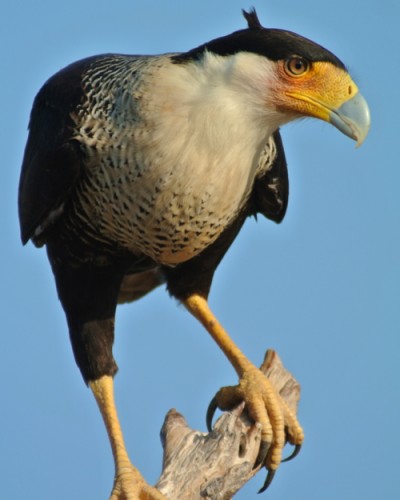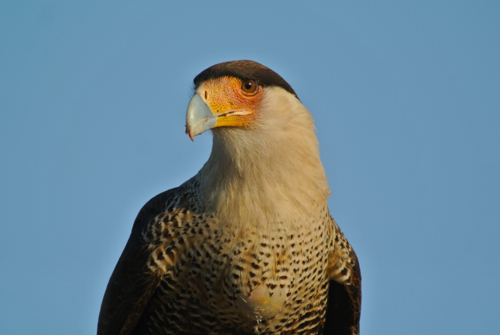 While in the Rio Grande Valley, my friend Marci asked if there were any birds I needed. I don't really have any lifers to get there but I said, "I'd like some quality time with a caracara."
While in the Rio Grande Valley, my friend Marci asked if there were any birds I needed. I don't really have any lifers to get there but I said, "I'd like some quality time with a caracara."
She smiled slyly and said, "I think I know a way to do that."
I've seen crested caracaras in Texas and Florida, but generally as they fly by or perch momentarily. I've had opportunity to get ok photos of them at Laguna Atascosa but not on a great, sunny day.
Marci hooked me up with a place called Martin Ranch also known as Martin Refuge on their website. I blogged a little about about this place on 10,000 Birds, it's a ranch specifically set up for photographers. They have water features to bring migrant songbirds, seed feeders and meat feeders. I know baiting is an issue for people and there's a forum to discuss at on my post at 10,000 Birds, this post is more to show all the different birds that came in during my session at a photography blind. I don't really see this meat feeding station as being too different from a seed or suet feeder, only instead of seed, mealworms and beef liver fat the birds are offered taxidermy leftovers, roadkill and chicken parts from the grocery store.
For a fee, you can visit this ranch and set yourself up in their photo blinds. There are different blinds at different angles so you can sit some place with the sun behind you throughout the day.
There are comfy lawn chairs set up inside the blind and curtains to hide your movement from the birds. Our blind easily held three people but a fourth could have been added. All would have had plenty of space to photograph birds.
I have a digiscoping set up and this place is primarily used by traditional sorts of photographers. I was able to get photos, but the birds were often too close with my set up to get full body shots with my Nikon V1 and Swarovski ATX scope and I didn't really have the option to switch lenses. But I got some great shots of the birds and a chance to see things like the somewhat gross looking crop bulge that pops out of their feathers after eating.
But getting head shots of crested caracaras was just fine and dandy with me! And at the end of the day, I'm a wildlife watcher first and photographer second, it was so fun to just have a session to watch gratuitous caracara action, listen to there gutteral calls, chase each other and just chowing down--it was amazeballs!
My iPhone 4s has a wider field of view with the scope than my camera, so I was able to get some full body shots with that. I love this bird, it looks like it has a "little captain in him." Another fun thing that we got to see were some of the facial skin changes. When a crested caracara is not stressed, it has colorful facial skin, note the above reddish faced adult.
Check out this younger bird with the grayer face--that means it feels threatened and the skin color can change in only a few seconds. Another bird was about to take this bird's hunk of meat.
There were at least 3 different caracaras that flew in missing their entire foot or several toes. I wonder if someone on a nearby ranch has some leg hold traps to get mammals and get these carrion eating by mistake. Again, I admire bird resilience. I'm sure this ranch's feeding station helps the flying wounded. What was interesting to watch was one of the one-footed bird's ability to sneak in to the flock of caracaras and steal a hunk of meat right from under a two-footed bird. I suppose it's that sort of aggressiveness that helps a bird that just lost its foot to keep going.
I think this is my favorite shot of the day. This is one of the one-footed caracaras chowing down on some chicken and managing fairly well to grasp some meat and to eat.
Of course other species of meat eating birds came in to the feed pile. Here's a Harris's hawk. Only one came in and it seemed a bit on guard. The caracaras readily flew down as soon as the meat was out. The Harris's hawk watched the scene a long time before finally landing and tucking into some chicken.
A couple of turkey vultures flew in and landed on the perching tree. They never came down. I'm not sure if it was all the caracaras that kept them at bay or the sound of camera shutters clicking madly, but they were far to wary to come in to the meat.
Black vultures, however, jumped right into the fray and even chased off a few caracaras. Very interesting considering they are so much smaller than the turkey vultures, but every species has its own style when approaching a food source.
OK, this bird didn't come into the meet, but to the water and the seed feeder. When I first got into the photography blind and all the birds came in at once, I went into nature sensory overload and my brain went a little nuts. I didn't know what to focus on first, the running monolog in my head was, "Caracaras, adults, juveniles, ACK, pyrrhuloxia, caracars, no turkey vulture, ack, black vulture, ack, caracaras, in perfect light, ah cool caracara sound, oh no pyrrhuloxia is back, must digiscope for big year, ack, vultures, ack ack ack, Harris's hawk, ack, caracara, ack."
Though I would replace all the "acks" with other four letter words one mutters when excited.
As if all of that weren't exciting enough, Marci's husband Terry was next to me and got super excited. I'm not sure actual words were coming out of his mouth as opposed to sounds humans make when incredibly stoked. I've done this and I've heard many a birder do it. I looked in the direction Terry's eyes were focused on...which was right in front of the blind and saw:
A really LONG rattle snake--that thing was HUGE. We tried to alert the photographers in the blind next to us and then all the cameras went bonkers. This snake was almost as long as me, so I'm guessing it was about four and a half feet long and clearly had been feeding well. The caracaras noted it but didn't seemed too perturbed by it. I think the snake sensed our excitement and turned around to go up the bank.
It was far too close for me to digiscope but I did manage to get a shot of its rattly tail. Wow, last August in Arizona was my first ever rattlesnake and now like a nemesis bird that I've finally seen, I'm seeing another right away. That's 2 rattlesnakes in less than a year...it did make me a little nervous later on when I had to duck out of the blind to find an obliging bush to pee in...I searched a little more thoroughly before I began
 It's not cheap to use a photography blind, but you are getting something that you don't get in the wild: the chance to sit fairly comfortably with a reasonable guarantee to see a certain species in good light and perched in ways for you to get dramatic and interesting photos. It's also an opportunity to watch birds that are comfortable engage in behaviors you wouldn't see when you surprise them in the field. I had a blast and I would do it again. If getting photos of birds is your thing, I would highly recommend checking out Martin Refuge.
It's not cheap to use a photography blind, but you are getting something that you don't get in the wild: the chance to sit fairly comfortably with a reasonable guarantee to see a certain species in good light and perched in ways for you to get dramatic and interesting photos. It's also an opportunity to watch birds that are comfortable engage in behaviors you wouldn't see when you surprise them in the field. I had a blast and I would do it again. If getting photos of birds is your thing, I would highly recommend checking out Martin Refuge.
Here's a video I made of some of the action--you can even hear a little caracara calling:
http://www.youtube.com/watch?v=U2bOZMaa8vM&feature=youtu.be















